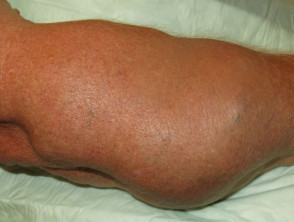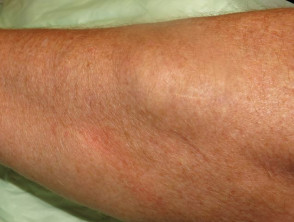What is Dercum disease?
Dercum disease is also known as adiposis dolorosa. It is a rare disease characterised by a combination of features:
- Multiple encapsulated fat overgrowths (lipomas) on the trunk and limbs
- Painful subcutaneous plaques
- Ecchymoses (bruises) without noticed trauma.
Dercum disease may be associated with obesity, emotional upset and fatigue.
It was first described in 1892, by Dercum, who named the disease 'adiposis dolorosa' to describe the painful adiposities (fat accumulations) seen in his 3 patients.
Multiple painful lipomas
Who gets Dercum disease?
Dercum disease affects women more frequently than men (reportedly 5–30 times more common in women than in men).
- It usually appears between 35 and 50 years of age.
- It may be more common in people with obesity.
Most people with Dercum disease do not have a family history of Dercum disease. However, the disease has been reported as showing an autosomal dominant pattern of inheritance in some families (ie the children of someone with Dercum disease have a 1-in-2 likelihood of also developing it.)
How is Dercum disease diagnosed?
A diagnosis of Dercum disease can be made through a systematic physical examination and identification of the characteristic triad of features (multiple lipomas, painful plaques and obesity).
Multiple lipomas may also be features of:
- Multiple lipomatosis (familial or sporadic)
- Fibromyalgia
- Panniculitis
- Obesity without painful plaques
- Cushing syndrome, which may also lead to abnormal fat distribution and ecchymoses.
A biopsy may be helpful to distinguish a lipoma from an angiolipoma (another type of painful fat overgrowth).
Other lesions that may mimic a lipoma include:
- Epidermoid cysts (which usually have a central punctum)
- Hibernoma
- Lipofascial hernia (a hernia in the anal or perianal region)
- Lipoedema.
What is the treatment for Dercum disease?
Dercum disease seems to benefit from the patient losing weight. Surgical excision or liposuction of selected lipomas may help, especially when they are in inconvenient locations. Surgical excision of many lipomas is not usually thought to be helpful and risks surgical complications.
Conventional pain medicines do not seem to reduce the discomfort associated with Dercum disease. Some reports do suggest that a local anaesthetic injection or patch can provide relief for intractable pain.

